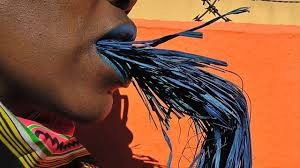Images as we consider them had not taken the form that we recognize. It seems to us that visually, for example, the natural world must be put together or perceived in a certain fashion.
Whatever our language, we perceive trees, ,mountains, people, oceans. We never see a man merge with a tree, for example. This would be considered an hallucinatory image. Our visual data are learned and interpreted so that they appear as the only possible results of those data. Inner vision can confound us, because in our mind we often see images quite clearly that we would dismiss if our eyes were open. In the terms of which we are speaking, however, the young species utilized what I have called the “inner senses” to a far greater degree than we do. Visually, early man did not perceive the physical world in the way that seems natural to us.
When a man’s and woman’s consciousness, for example, blended with that of a tree, those data, became “visual” for others to perceive. When a man’s/woman’s consciousness merged with an animal’s that blending became visual data also.
In a manner of speaking, the brain put visual information together so that the visual contents of the world were not as stationary as they are now. We have learned to be highly specific in our physical sight and interpretations. Our mental vision holds hints as to data that could be, but are not visually, physically perceived. We have trained ourselves to react to certain visual cues which trigger our mental interpretations, and to ignore other variations.
These later can be described as too subtle. Yet actually they are no more subtle than those cues we acknowledge.
Data, we say, are stored in the chromosomes, strung together in a certain fashion. Now biologically that is direct cognition. The inner senses perceive directly in the same fashion. To us, language means words. Words are always symbols for emotions or feelings, intents or desires. Direct cognition did not need the symbols. The first language, the initial language, did not involve images or words, but dealt with a free flow of directly cognitive material.
A man or woman, wondering what a tree was like, became one, and let his or her own consciousness flow into the tree. Man’s/woman’s consciousness mixed and merged with other kinds of consciousness with the great curiosity of love. A child did not simply look at an animal, but let its consciousness merge with the animal’s and so to some extent the animal looked out through the child’s eyes.
In ways most difficult to explain, man and woman “absorbed” an animal’s spirit before he/she killed it, so that the spirit of the animal merged with his or her own. In using the animal’s flesh, then, the hunter believed that he or she was giving the animal a new focus of existence. He/she could draw on the animal’s strength, and therefore were one.
Our own kind of focus emerged from such a background, so that within ourselves we contain myriad consciousnesses of which we are unaware. Through our own particular focus, the consciousnesses of the natural world merged to form a synthesis in which, for example, symphonies can emerge. We act not only for ourselves, but also for other kinds of consciousness that we have purposefully forgotten. In following our own purposes, which are ours, we also serve the purposes of others we have forgotten.
In thinking our own private thoughts, we also add to a larger psychic and mental reality of which we are part. Our language program our perceptions, and limit our communications in certain terms, as much as they facilitate it.
A musician writing a symphony, however, does not use all of the notes that are available to him. He or she chooses and discriminates. His/her discrimination is based upon his/her knowledge of the information available, however. In the same way, our languages are based upon an inner knowledge of larger available communications. The “secrets” of language are not to be found, then, in the available sounds, accents, root words or syllables, but in the rhythms between the words; the pauses and hesitations; the flow with which the words are put together, and the unsaid inferences that connect verbal and visual data.
As a species “We” sought certain kinds of experience. Individually, and as tribes or nations, we follow certain “progressions” — and yet in so doing we act also on the part of the whole of nature. We take into our bodies in transmuted form the consciousness of all the things we consume.
The consciousness then merge to perceive the world in a fashion we call our own. Through our eyes the beasts, vegetables, birds, and dust perceive the dawn and sunlight as we do — as us, and yet on the other hand our experience is our own.
To some extent it is true to say that languages emerged as we began to lose direct communication with our own experience, and with that of others. Language is therefore a substitute for direct communication. The symbols of the words stand for our own or someone else’s experience, while protecting us or them from it at the same time.
Visual data as we perceive them amount to visual language; the images perceived are like visual words. An object is presented to our visual perception so that we can safely perceive it from the outside. Objects as we see them are also symbols.








